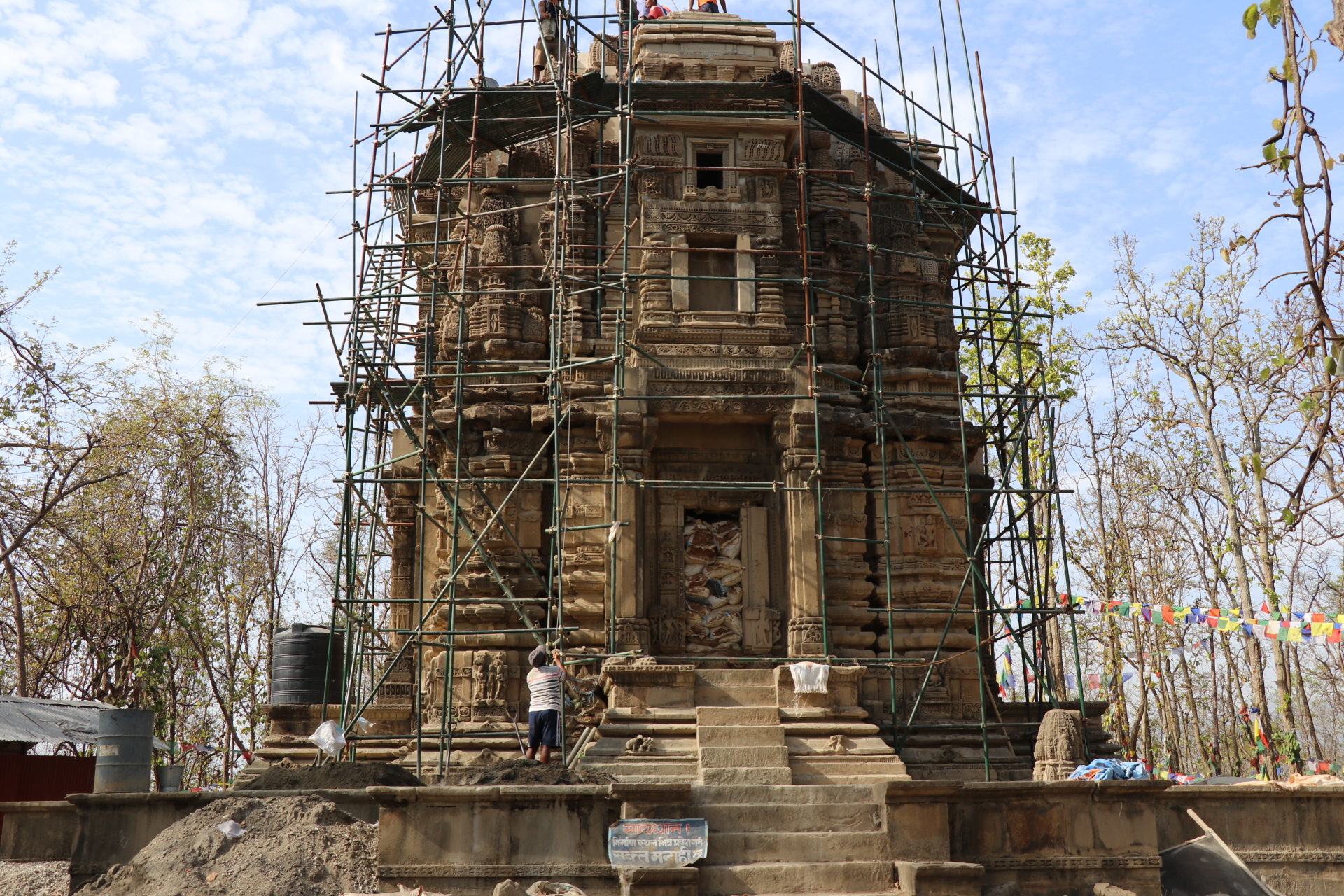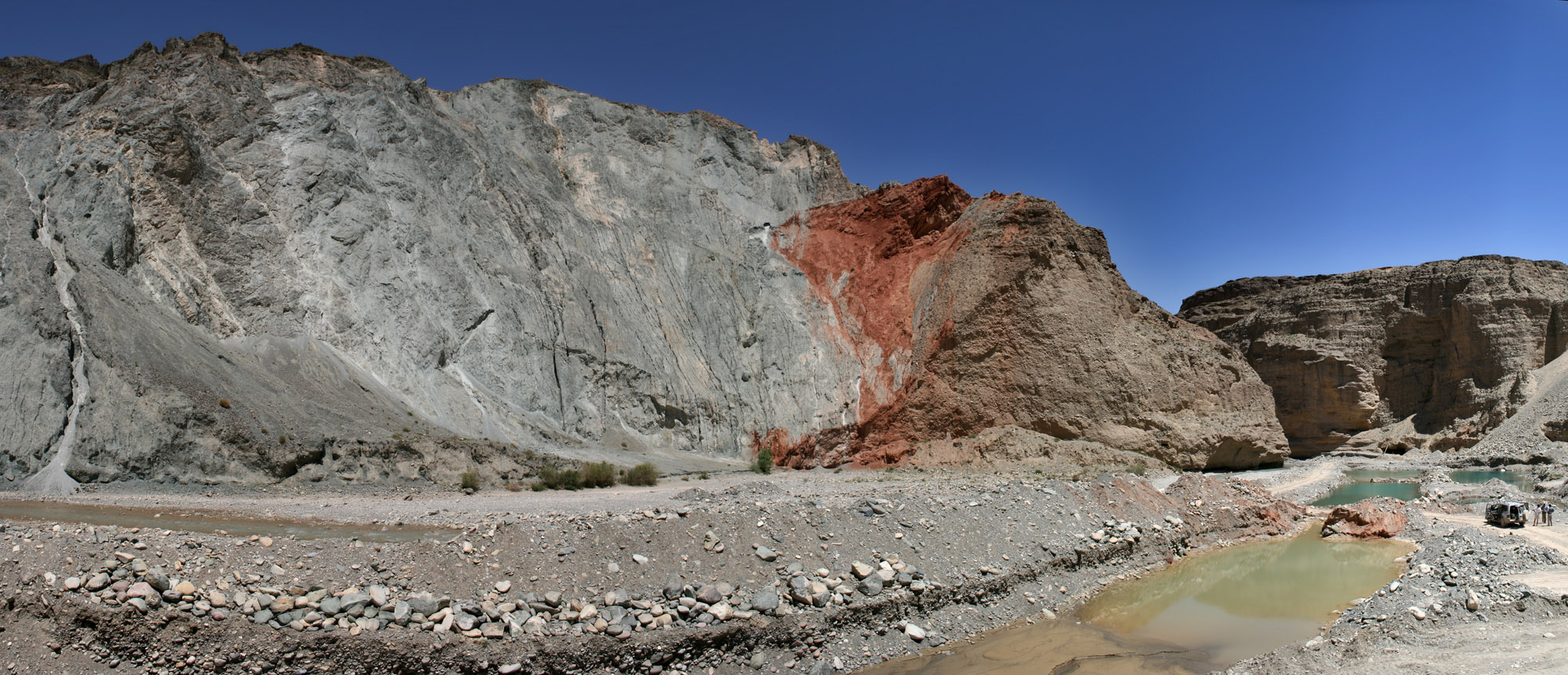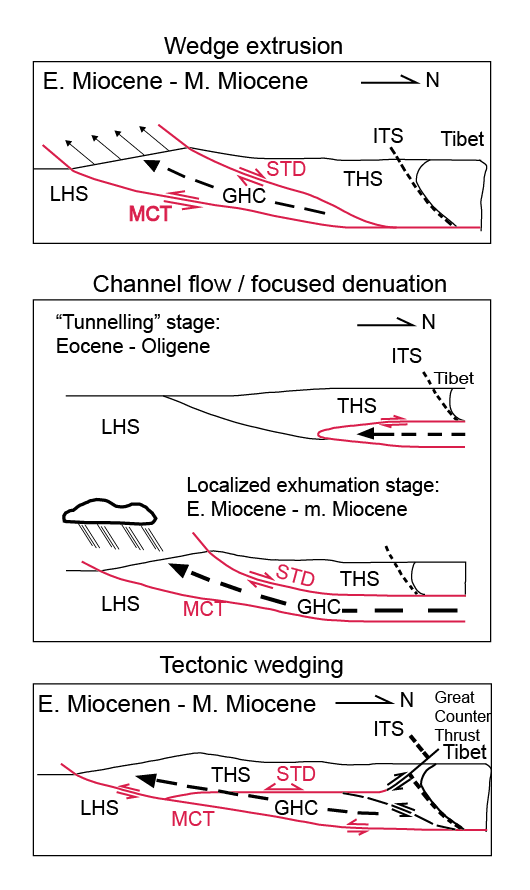|
Main Boundary Thrust
The Main Boundary Thrust (MBT), also known as the Main Boundary Fault, is a discontinuous series of seismic faults in the Himalayas which form the structural boundary between the Outer Himalayas and Lower Himalayan Range. The MBT is itself part of a series of thrusts which helped to accommodate the deformation when the Indian Plate collided with the Eurasian Plate in the Cenozoic. The MBT fault system began forming in the Miocene. The MBT consists of multiple segments, and is composed from west to east of the Murree and Drang thrust faults, the Krol thrust fault, the Surkhet-Ghorahi thrust fault, the Kathmandu thrust, and the Gondwana/Garu thrust. Despite originating as a thrust fault in the collision of India and Eurasia, the MBT system has reactivated as a normal faulting system. Tectonic setting The MBT was formed as a result of the collision of the Indian continent with Asia. It developed to relieve stresses from the compression of the continental collision. When the MB ... [...More Info...] [...Related Items...] OR: [Wikipedia] [Google] [Baidu] |
India
India, officially the Republic of India, is a country in South Asia. It is the List of countries and dependencies by area, seventh-largest country by area; the List of countries by population (United Nations), most populous country since 2023; and, since its independence in 1947, the world's most populous democracy. Bounded by the Indian Ocean on the south, the Arabian Sea on the southwest, and the Bay of Bengal on the southeast, it shares land borders with Pakistan to the west; China, Nepal, and Bhutan to the north; and Bangladesh and Myanmar to the east. In the Indian Ocean, India is near Sri Lanka and the Maldives; its Andaman and Nicobar Islands share a maritime border with Thailand, Myanmar, and Indonesia. Modern humans arrived on the Indian subcontinent from Africa no later than 55,000 years ago., "Y-Chromosome and Mt-DNA data support the colonization of South Asia by modern humans originating in Africa. ... Coalescence dates for most non-European populations averag ... [...More Info...] [...Related Items...] OR: [Wikipedia] [Google] [Baidu] |
Compression (geology)
In geology Geology (). is a branch of natural science concerned with the Earth and other astronomical objects, the rocks of which they are composed, and the processes by which they change over time. Modern geology significantly overlaps all other Earth ..., the term compression refers to a set of stresses directed toward the center of a rock mass. Compressive strength refers to the maximum amount of compressive stress that can be applied to a material before failure occurs. When the maximum compressive stress is in a horizontal orientation, thrust faulting can occur, resulting in the shortening and thickening of that portion of the crust. When the maximum compressive stress is vertical, a section of rock will often fail in normal faults, horizontally extending and vertically thinning a given layer of rock. Compressive stresses can also result in the folding of rocks. Because of the large magnitudes of lithostatic stress in tectonic plates, tectonic-scale deformation ... [...More Info...] [...Related Items...] OR: [Wikipedia] [Google] [Baidu] |
Fault Scarp
A fault scarp is a small step-like offset of the ground surface in which one side of a fault has shifted vertically in relation to the other. The topographic expression of fault scarps results from the differential erosion of rocks of contrasting resistance and the displacement of land surface by movement along the fault. Differential movement and erosion may occur either along older inactive geologic faults, or recent active faults. Characteristics Fault scarps often involve zones of highly fractured rock and discontinuities of hard and weak consistencies of rock. Bluffs can form from upthrown blocks and can be very steep, as in the case of Pakistan's coastal cliffs. The height of the scarp formation tends to be defined in terms of the vertical displacement along the fault. Active scarp faults may reflect rapid tectonic displacement and can be caused by any type of fault including strike-slip faults. Vertical displacement of ten meters may occur in fault scarps in volcanic bed ... [...More Info...] [...Related Items...] OR: [Wikipedia] [Google] [Baidu] |
Bheri River
The Bheri River is a major tributary of the ''Karnali River'' draining the western Dhaulagiri range in western Nepal. It has three important upper tributaries. Sani Bheri River drains southern slopes of this range while Thuli Bheri River drains northern slopes. Another tributary ''Uttar Ganga'' drains Dhorpatan Valley to the south of the Dhaulagiris. Downstream, the Bheri flows through Surkhet Valley before joining the Karnali River in the '' Mahabharat Range'' or ''Lesser Himalaya The Himalayas, or Himalaya ( ), is a mountain range in Asia, separating the plains of the Indian subcontinent from the Tibetan Plateau. The range has some of the Earth's highest peaks, including the highest, Mount Everest. More than 100 pea ...''. On December 25, 2007, a suspension bridge collapsed along the river in Chhinchu (Mehelkuna) village. "Scores" of people crossed the 500m steel bridge to get to a local Christmas Day fair. At least 15 people were killed and at least 22 were in ... [...More Info...] [...Related Items...] OR: [Wikipedia] [Google] [Baidu] |
Ghorahi
''Ghorahi'' (Nepali: घोराही उपमहानगरपालिका) is the largest sub-metropolitan city by area and population of Lumbini Province. The city (formerly Tribhuvannagar) lies in Lumbini Province in the Mid-Western part of Nepal. It is the largest city of Dang Deukhuri District of southwest Nepal. Located in the Inner Terai region, it lies south-west of Nepal's capital, Kathmandu, and is one of the Counter Magnets being developed as an alternative centre of growth to help ease the migration and population explosion in the Kathmandu metropolitan area. It is the largest city of the Rapti Zone and is surrounded by the Sivalik Hills to the south and Mahabharata Range to the north. Ghorahi is located in the Dang Valley in the foothills of the Himalayas nestled between the Babai River in the east, south, and in the west which ends being the famous Sarayu and Ganges rivers in India. The city is known for its landscape and slightly milder climate and ... [...More Info...] [...Related Items...] OR: [Wikipedia] [Google] [Baidu] |
Surkhet District
Surkhet District (, ) is a district in Karnali Province of mid-western Nepal. Surkhet is one of the ten districts of Karnali located about west of the national capital Kathmandu. The district's area is . It had 288,527 population in 2001 and 350,804 in 2011 which male comprised 169,461 and female 181,381. Its district headquarters, Birendranagar, is the capital of Karnali Province. It is serving as a business hub and document center for Karnali province. According to population, development, road links, landforms, climate, many peoples are migrating here. After becoming province capital developmental activities are boosted and are in peak level. All the governmental works are carried here. Birendranagar is beautiful valley surrounded by hills having moderate climate. Geography and Climate Surkhet Valley is one of the Inner Terai Valleys of Nepal. It borders Achham district of Sudurpashchim, Dailekh and Jajarkot districts to the north, Salyan district to the east, Banke and ... [...More Info...] [...Related Items...] OR: [Wikipedia] [Google] [Baidu] |
Himachal
Himachal Pradesh (; Sanskrit: ''himācāl prādes;'' "Snow-laden Mountain Province") is a States and union territories of India, state in the northern part of India. Situated in the Western Himalayas, it is one of the thirteen Indian Himalayan Region, mountain states and is characterised by an extreme landscape featuring List of mountain peaks of Himachal Pradesh, several peaks and extensive river systems. Himachal Pradesh is the northernmost state of India and shares borders with the union territories of Jammu and Kashmir (union territory), Jammu and Kashmir and Ladakh to the north, and the states of Punjab (India), Punjab to the west, Haryana to the southwest, Uttarakhand to the southeast and a very narrow border with Uttar Pradesh to the south. The state also shares an international border to the east with the Tibet Autonomous Region in China. Himachal Pradesh is also known as ''Dev Bhoomi'', meaning 'Land of Gods' and ''Veer Bhoomi'' which means 'Land of the Brave'. The pre ... [...More Info...] [...Related Items...] OR: [Wikipedia] [Google] [Baidu] |
Kashmir
Kashmir ( or ) is the Northwestern Indian subcontinent, northernmost geographical region of the Indian subcontinent. Until the mid-19th century, the term ''Kashmir'' denoted only the Kashmir Valley between the Great Himalayas and the Pir Panjal Range. The term has since also come to encompass a larger area that includes the Indian-administered territories of Jammu and Kashmir (union territory), Jammu and Kashmir and Ladakh, the Pakistani-administered territories of Azad Kashmir and Gilgit-Baltistan, and the Chinese-administered territories of Aksai Chin and the Trans-Karakoram Tract. Quote: "Kashmir, region of the northwestern Indian subcontinent. It is bounded by the Uygur Autonomous Region of Xinjiang to the northeast and the Tibet Autonomous Region to the east (both parts of China), by the Indian states of Himachal Pradesh and Punjab to the south, by Pakistan to the west, and by Afghanistan to the northwest. The northern and western portions are administered by Pakistan a ... [...More Info...] [...Related Items...] OR: [Wikipedia] [Google] [Baidu] |
Thrust Fault
A thrust fault is a break in the Earth's crust, across which older rocks are pushed above younger rocks. Thrust geometry and nomenclature Reverse faults A thrust fault is a type of reverse fault that has a dip of 45 degrees or less. If the angle of the fault plane is lower (often less than 15 degrees from the horizontal) and the displacement of the overlying block is large (often in the kilometer range) the fault is called an ''overthrust'' or ''overthrust fault''. Erosion can remove part of the overlying block, creating a ''fenster'' (or ''window'') – when the underlying block is exposed only in a relatively small area. When erosion removes most of the overlying block, leaving island-like remnants resting on the lower block, the remnants are called ''klippen'' (singular '' klippe''). Blind thrust faults If the fault plane terminates before it reaches the Earth's surface, it is called a ''blind thrust'' fault. Because of the lack of surface evidence, blind thrust fa ... [...More Info...] [...Related Items...] OR: [Wikipedia] [Google] [Baidu] |
Main Frontal Thrust
The Main Frontal Thrust (MFT), also known as the Himalayan Frontal Thrust (HFT), is a geological fault in the Himalayas that defines the boundary between the Himalayan foothills and Indo-Gangetic Plain. The fault is well expressed on the surface thus could be seen via satellite imagery. It is the youngest and southernmost thrust structure in the Himalaya deformation front. It is a splay branch of the Main Himalayan Thrust (MHT) as the root décollement. Background It runs parallel to other major splays of the MHT, the Main Boundary Thrust (MBT) and Main Central Thrust (MCT). The Sunda Megathrust, which extends from the Banda Islands to Myanmar, is joined with the MFT. The fault strikes in a northwest-southeast direction and dips at an angle of 20° to 30° in the north. The Main Boundary Thrust is another major thrust fault in the Himalaya orogenic wedge that was active in the Cenozoic. It runs parallel to the MFT with a spacing distance of about 20 km. Shortening ... [...More Info...] [...Related Items...] OR: [Wikipedia] [Google] [Baidu] |
South Tibetan Detachment
The South Tibetan Detachment is one of the major Fault (geology), faults in the Himalaya Mountains. Background Understanding the formation of the Himalayan mountains has been a goal of structural geologists for a long time. Many of the problems and disagreements that geologists have with each other concerning the Himalayan orogeny involve the relationship between the observed geometry, or structures, with the various rock units (different types of rock). There are three primary rock units present in the Himalaya: the Lesser Himalayan Sequence (LHS; mainly low-grade Proterozoic metasediments, ''yellow in map''), the Greater Himalayan Crystalline complex (GHC; largely high-grade paragneisses and migmatite, ''orange in map''), and the Tethyan Himalayan Sequence (THS; dominantly low-grade late Proterozoic to Eocene shelf sediments; ''blue in map'') More information about these rock units can be found by reading about the geology of Nepal. Because the Himalaya form on the leading edge of ... [...More Info...] [...Related Items...] OR: [Wikipedia] [Google] [Baidu] |
Main Central Thrust
The Main Central Thrust is a major geological fault where the Indian plate has pushed under the Eurasian plate along the Himalaya. The fault slopes down to the north and is exposed on the surface in a NW-SE direction (strike). It is a thrust fault that continues along 2900 km of the Himalaya mountain belt.Upreti, B. N.An overview of the stratigraphy and tectonics of the Nepal Himalaya ''Journal of Asian Earth Sciences'' 17.5 (1994): 577–606. The generally accepted definition of the Main Central Thrust is that it is a ductile shear zone along which the High-grade Great Himalayan Crystalline complex was placed above the low-grade to unmetamorphosed Lesser Himalayan Sequence.Helm, A., and A. Gansser. "Central Himalaya, Geological observations of the Swiss expedition 1936." ''Memoires de la Societe Helvetique des Sciences Naturelles'' 73.1,245 (1939). However, this definition is not perfect because of many difficulties and complications defining the Main Central Thrust. Many ge ... [...More Info...] [...Related Items...] OR: [Wikipedia] [Google] [Baidu] |







